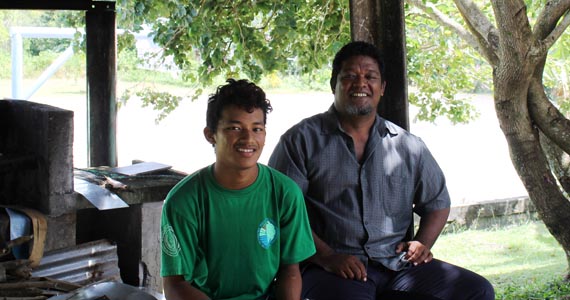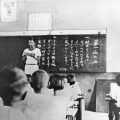Bridging the Xavier-Sapuk Gap
I’ve been back in Chuuk for the past week as part of an effort to push education reform there. Toward the end of the week, I found myself back at Xavier High School–the place where I was first introduced to the islands just 50 years ago. Xavier is also the new home for the MicSem library. So this trip was something of a sentimental journey for me.
But the flow of memories took some strange turns. Barely an hour after my arrival at Xavier, a man came up and introduced himself as Basilio, one of the workmen at the school. When I told him that I was once director of the school, he said that he remembered me at that time. I asked him how long he had been working at Xavier. ?Six years,? he said. ?Not far enough back,? I replied, ?I was director long before then, during the 1970s.? He smiled but insisted that he knew me long before he began working with the school. ?Don?t you remember?? he said. ?I was the guy you tackled and arrested when I was drunk one day.?
Sure I remembered. Who could forget it? One day, as I was playing basketball in the school gym, one of the students came running up with the news that a kid from Sapuk was stoning the flatbed truck that was bringing the Xavier girls back to their homes. I dashed out of the gym, ran down the road and found the trouble-maker staggering along the road. When he saw me, he started to run, so I tackled him. While the two of us were rolling around in a taro patch, women appeared from everywhere and began trying to peel me off the boy. In a few minutes Jim Croghan roared up with the Xavier pickup, so we tossed the delinquent in the back and brought him to the Chuuk police station. There he was immediately booked, stripped down to his underwear, and thrown into the lockup for a couple of days. I recall returning to his house at the turn up the hill to Xavier and explaining to his family that he had been arrested. They greeted this news with tight faces and stony silence, but I assured them that the boy would be released in a couple of days.
Three days later a couple of women from his family appeared in my office and told me that the boy had been released a day before but had not returned home. They asked if we could help look for his body since they presumed he had taken his life after his release. Suicide was common enough then and since to be a real fear. So that evening the Xavier boys spent two hours searching everywhere for the body of the boy who had been arrested for stoning our girls. We never did find the body. Still, we were all relieved the next day to hear that he was alive and well. He had just decided to stay with relatives in town that night and had appeared at his family?s house the next morning.
I wondered over the years what had happened to the boy. It was gratifying to find that the kid who had been Public Enemy #1 for a weekend was now employed by the school that he terrorized so briefly.
He?wasn’t?the only example of the bridges that are built over the years. As Rich McAuliff, the Director of Xavier, was showing me around the campus, he pointed out another Xavier workman whom I might have known. The man was just a young boy in the 1960s, during my first stint at the school, when a Palauan student at Xavier whipped out a revolver and shot him in the leg. The student, who was in the thrall of the old westerns shown on Friday evenings in those days, was just practicing his fast draw on approaching a young kid from the village below the school.? But the gun went off, wounding the kid in the leg. Later the boy?s family came to the school afterwards to advise the principal that the gunshot was just an accident and that he should not be tossed out of Xavier.? He?wasn’t? but a few months later his fate was sealed when he was caught drinking with some classmates.
Visitors are always amazed at what they see at Xavier: an educational sensation, with its polite and articulate student body, its alumni roll reading like a Who?s Who of Micronesia, its list of Gates Scholars in recent years. But an old hand like me expects no less of the school. What does impress me, though, is the way in which the old ?town-gown? rivalry has been laid to rest. Xavier teachers and students tutor at Sapuk Elementary School, kids from the village are invited to use the school basketball court, and Sapuk and Xavier seem comfortable in one another?s presence at long last. When the stone-throwers and the shooting victims join the school staff,?we’ve?taken a big step forward.






